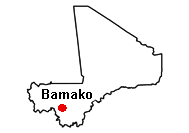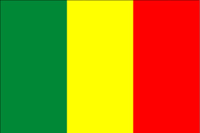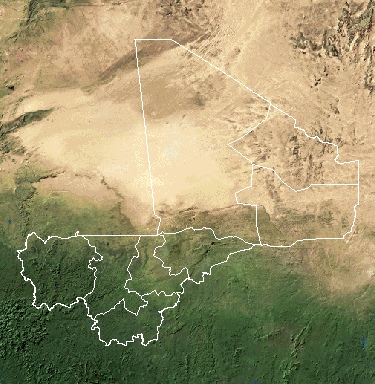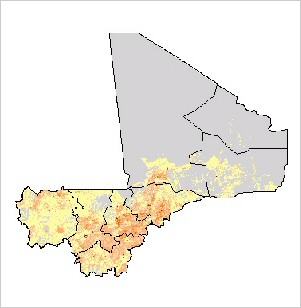|
|
 |
| back to top | |||
|
Population. Estimated to be 200 to 500, believed to be much less than this currently. Probably a small population still exists in the north west of the country bordering Mauritania and in the south part of Adghagh nrquote Iforas chain, where cheetah have been reported in late 1970's. In 1990 skins were found for sale in Tibuta, north Mali. There were a few cheetahs in Gurma National Park in the 1970's. In 1999 a preliminary study of the status of the cheetah in the massif of Adrar des Iforas found no confirmed presence of the cheetah. However, a series of reported observations leave some hope that the species still exists in Mali in the region of Kidal in the northeast of the country close to the border to Algeria. Principal Threats. Decline of prey, poaching, environmental desiccation and reduction of habitat due to drought conditions |
|||
|
|||
|
The Sudanese Republic and Senegal became independent of France in 1960 as the Mali Federation. When Senegal withdrew after only a few months, what formerly made up the Sudanese Republic was renamed Mali. Rule by dictatorship was brought to a close in 1991 by a coup that ushered in democratic government. President Alpha KONARE won Mali's first democratic presidential election in 1992 and was reelected in 1997. In keeping with Mali's two-term constitutional limit, KONARE stepped down in 2002 and was succeeded by Amadou TOURE. |
|||
| back to top | ||
|
|
||
|
|
|
 |
|
Area: total: 1.24 million sq km; land: 1.22 million sq km; water: 20,000 sq km Climate: subtropical to arid; hot and dry February to June; rainy, humid, and mild June to November; cool and dry November to February Terrain: mostly flat to rolling northern plains covered by sand; savanna in south, rugged hills in northeast Natural resources: gold, phosphates, kaolin, salt, limestone, uranium, bauxite, iron ore, manganese, tin, and copper deposits are known but not exploited Land use: arable land: 3.76%; permanent crops: 0.03%; other: 96.21% (2005) rrigated land: 2,360 sq km (2003) Natural hazards: hot, dust-laden harmattan haze common during dry seasons; recurring droughts Environment-current issues: deforestation; soil erosion; desertification; inadequate supplies of potable water; poaching Environment-international agreements:
|
||
| back to top | ||
|
Population: 11,716,829 (July 2006 est.) Age structure: 0-14 years: 48.2% (male 2,857,670/female 2,787,506); 15-64 years: 48.8% (male 2,804,344/female 2,910,097); 65 years and over: 3% (male 146,458/female 210,754) (2006 est.) Median age: total: 15.8 years; male: 15.4 years; female: 16.3 years (2006 est.) Population growth rate: 2.63% (2006 est.) Infant mortality rate: total: 107.58 deaths/1,000 live births; male: 117.32 deaths/1,000 live births; female: 97.54 deaths/1,000 live births (2006 est.) Life expectancy at birth: total population: 49 years; male: 47.05 years; female: 51.01 years (2006 est.) Total fertility rate: 7.42 children born/woman (2006 est.) |
|
|
| HIV/AIDS - adult prevalence rate: 1.9%
(2003 est.) Distribution
of the human population in Mali HIV/AIDS - people living with HIV/AIDS: 140,000 (2003 est.) HIV/AIDS - deaths: 12,000 (2003 est.) Ethnic groups: Mande 50% (Bambara, Malinke, Sarakole), Peul 17%, Voltaic 12%, Songhai 6%, Tuareg and Moor 10%, other 5% Religions: Muslim 90%, indigenous beliefs 9%, Christian 1% Languages: French (official), Bambara 80%, numerous African languages Literacy: definition: age 15 and over can read and write; total population: 46.4%; male: 53.5%; female: 39.6% (2003 est.) |
||
|
|
||
| back to top | |
|
Data code: ML Government type: republic Independence: 22 September 1960 (from France) Legal system: based on French civil law system and customary law; judicial review of legislative acts in Constitutional Court (which was formally established on 9 March 1994); has not accepted compulsory ICJ jurisdiction Political pressure groups and leaders: Alliance for Democratic Change or ACD; Patriotic Movement of the Ghanda Koye or MPGK; United Movement and Fronts of Azawad or MFUA |
|
| back to top | ||
|
Economy-overview: Mali is among the poorest countries in the world, with 65% of its land area desert or semidesert. Economic activity is largely confined to the riverine area irrigated by the Niger. About 10% of the population is nomadic and some 80% of the labor force is engaged in farming and fishing. Industrial activity is concentrated on processing farm commodities. Mali is heavily dependent on foreign aid and vulnerable to fluctuations in world prices for cotton, its main export. In 1997, the government continued its successful implementation of an IMF-recommended structural adjustment program that is helping the economy grow, diversify, and attract foreign investment. Mali's adherence to economic reform, and the 50% devaluation of the African franc in January 1994, has pushed up economic growth. Several multinational corporations increased gold mining operations in 1996-98, and the government anticipates that Mali will become a major Sub-Saharan gold exporter in the next few years. Annual growth thus may fall in the 5% range in 1999-2000, and inflation held to 5% or less. GDP - real growth rate: 5.1% (2006 est.) GDP - composition by sector: agriculture: 45%; industry: 17%; services: 38% (2001 est.) Labor force: 3.93 million (2001 est.) Labor force-by occupation: agriculture and fishing 80% (1998 est.) Unemployment rate: 14.6% (2001 est.) Population below poverty line: 64% (2001 est.) Industries: minor local consumer goods production and food processing; construction; phosphate and gold mining |
||
|
Agriculture-products: cotton, millet, rice, corn, vegetables, peanuts; cattle, sheep, goats Exports: $590 million (f.o.b., 1998 est.) Exports-commodities: cotton 50%, gold, livestock (1998 est.) Exports-partners: Thailand 20%, Italy 20%, China 9%, Brazil, franc zone (1997) Imports: $600 million (f.o.b., 1998 est.) Imports-commodities: machinery and equipment, construction materials, petroleum, foodstuffs, textiles Imports-partners: Cote d'Ivoire 19%, France 17%, other franc zone and EU countries (1997) Currency: 1 Communaute Financiere Africaine franc (CFAF) = 100 centimes Exchange rates: Communaute Financiere Africaine francs (CFAF) per US$1-567.81 (January 1999), 589.95 (1998), 583.67 (1997), 511.55 (1996), 499.15 (1995), 555.20 (1994) |
|
Distribution of livestock in Mali |
|
|
||
| back to top | |
|
Telephone system:
domestic system poor but improving; provides only minimal service Radio broadcast stations: AM 2, FM 2, shortwave 1 Television broadcast stations: 1 (in addition, there are two repeaters) (1997) Internet country code: .ml Internet hosts: 278 (2006) Internet users: 60,000 (2005) |
|
|
|
|
| back to top |
|
Drieux-Dumont
A.-M. 2002. Etude préliminaire du statut du guépard du Sahara
(Acinonyx jubatus), Adrar des Iforas, Mali.
Marker L., Malouf J. and Malouf A. 1999. Appendix 2: The status of the wild cheetah in its range countries. In: 1999 International Cheetah Studbook. http://www.lib.utexas.edu/maps/mali.html |



